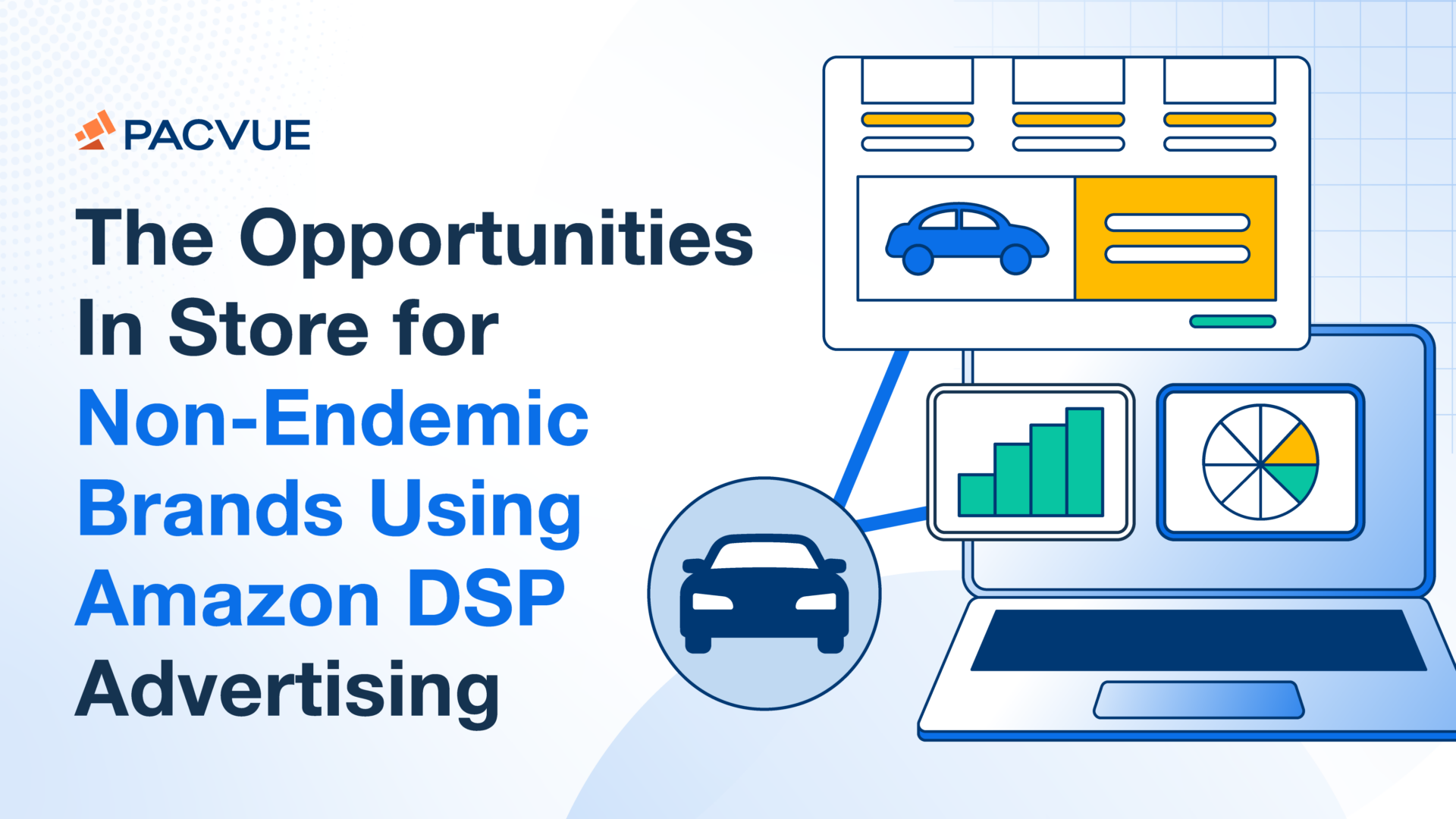Retail media networks are a hotbed of advertising activity for CPG brands, but what’s the appeal for brands whose products or services aren’t for sale on retailers’ dotcoms? Leading retailers like Amazon and Walmart are offering advertising services to non-endemic brands who can tap into the rich, unique, first-party datasets and vast retail media network audiences. In this article, we’ll be exploring the opportunities in store for non-endemic brands using Amazon DSP, or Demand-Side Platform — the programmatic advertising component of one of the world’s leading retail media networks. Find out:
- Why non-endemic brands are creating Amazon DSP advertising campaigns
- How non-endemic brands are using Amazon DSP as part of their overall strategy
- How to avoid the pitfalls of getting started with Amazon DSP with pro tips from our experts
Endemic vs non-endemic brands in retail media. What’s the difference?
To boost sales, endemic brands advertise on retailer websites that stock their products. Non-endemic brands advertise on retailer websites too, even though their products or services are not for sale on these channels. For example, a luxury travel company might create an ad campaign targeting Amazon shoppers searching for premium luggage brands. Compared with endemic brands, non-endemic brands have different advertising goals; they use extensive first-party data, harvested by retail media networks, to target in-market audiences they couldn’t otherwise reach.
Why are non-endemic brands leaning into retail media?
Several factors are disrupting the advertising landscape today. Retail media networks — by the likes of Amazon, Walmart and Target — are stepping in to help endemic and non-endemic brands raise their advertising game and seize new opportunities:
1. The richness of first-party data in retail media networks
Traditional digital advertising campaigns rely on cookies. Cookies capture third-party shopper behavior and preferences based on their browsing habits. They’re key to creating effective digital advertising campaigns. Google had planned to drop the use of cookies in response to increased pressure around consumer privacy and regulatory compliance.
However, last month, they backtracked on this decision. Despite cookies staying around (for now) retail media networks offering brands access to their first-party shopper data sets instead is a future-proof solution brands can use to enhance their cookie data.
This rich data allows you to build highly targeted campaigns based on real shopping trends including shoppers’ response to your ads, whether they arrived at your product page, bought your product during a promotion, or abandoned their cart.
2. The rise of connected TV (CTV) and retail media
Programmatic retail media platforms allow you to reach shoppers on or off the retailer’s dotcom. Non-endemic brands using Amazon DSP, for example, can extend their reach to other premium sites such as Amazon Prime’s Video Freevee, Twitch, and Kindle. (You can’t access these channels with traditional DSP providers.)
Connected TV or CTV advertising is available through Amazon’s many partner sites and products including Prime Video, gaming consoles, set-top boxes and streaming sticks. CTV offers a blend of the broad reach of traditional television and the precise targeting and measurability of digital advertising.
Brands are increasingly investing in CTV advertising to take advantage of its growing audience, enhanced targeting capabilities, high engagement rates, and extensive analytics. Non-endemic advertising campaigns that lend themselves to storytelling techniques are a perfect fit for connected TV and Sponsored Video media.
3. Retail media attribution and enhanced measurement
Retail media networks offer robust attribution models and detailed analytics that allow you to track the entire customer journey through various touchpoints. This gives you clear insights into campaign performance and accurate KPIs. This level of measurement is far more detailed than anything traditional search engines can offer.
Amazon Marketing Cloud (AMC) is a data clean room service, or ‘walled garden’ provided by Amazon Web Services (AWS) for advertisers. It allows them to analyze and measure the performance of their advertising campaigns in a privacy-safe environment. AMC integrates data from various sources, including Amazon’s own retail and advertising data, to provide insights on campaign performance, audience reach, and conversion metrics. You can read more about retail media attribution and measurement in Amazon Marketing Cloud here.
Five reasons why non-endemic brands are using Amazon DSP
US retail media spending will grow 30% in 2024, largely driven by offsite programmatic retail media platforms.
Source: Advertiser Perceptions
Retail media networks like Amazon and Walmart are democratizing their networks and opening their stores to non-endemic advertisers. The recent uptick in non-endemic brands using Amazon DSP is driven by the massive audience reach and data-driven advertising opportunities that these networks offer. Amazon Demand-Side Platform is one of the most popular aspects of Amazon’s retail media network.
Amazon DSP is fast-becoming the go-to advertising platform for non-endemic brands for several compelling reasons:
1. Amazon DSP’s audience reach
Amazon allows endemic and non-endemic brands to access its vast and diverse audience data, including millions of active shoppers. Non-endemic brands, such as financial services, automotive, insurance or travel companies, can leverage this reach to promote their services to a wide audience of shoppers who may not be directly searching for their products but display similar interests.
2. Extensive targeting capabilities in Amazon DSP
Unlike Amazon DSP, traditional demand-side platforms don’t have data that is as closely linked to the shoppers’ point of purchase. With Amazon DSP, you can target audiences based on their purchase behavior, not just purchase intent. Using Amazon Marketing Cloud audiences, brands can create highly sophisticated campaigns. You can find out how to tap into AMC audiences when planning DSP campaigns here in our simple guide.
3. Amazon DSP and programmatic buying
Amazon DSP supports programmatic ad buying. This means you can automate the purchasing of ad space in real-time. This efficiency helps you optimize your ad spending and improve the performance of your campaigns.
4. Diverse ad formats in Amazon DSP advertising
Amazon DSP supports various advertising formats, including display, video, and audio ads. This versatility allows you to create engaging and dynamic campaigns that capture the attention of your target audience across multiple touchpoints.
5. Measurable results and analytics
With Amazon DSP you get access to detailed analytics and reporting tools. You can track the performance of their campaigns, measure key metrics such as impressions and clicks, and make data-driven decisions to optimise your advertising strategies.
Non-endemic brands using Amazon DSP can effectively reach a large and diverse audience, utilize advanced targeting capabilities, and create impactful, cost-effective advertising campaigns. These benefits are driving more non-endemic brands to explore Amazon’s programmatic advertising platform. Here are some examples:
Examples of non-endemic brands advertising on Amazon
Non-endemic brands leveraging Amazon’s advertising platform to reach their target audiences include household names from sectors spanning automotive, insurance, financial services, travel, and more.
GoDaddy uses Amazon DSP to target entrepreneurs
GoDaddy, a web hosting and domain registration service, uses Amazon’s Demand-Side Platform (DSP) to target business owners and entrepreneurs. By utilizing Amazon’s customer behavior and demographic data, GoDaddy can reach potential customers who are likely interested in starting or enhancing their online presence.
Chevrolet uses Amazon DSP advertising to promote the Chevrolet Groove in Mexico
The automotive manufacturer’s Amazon Ads campaign included Twitch livestreams, a custom Amazon landing page, and Amazon DSP display ads. The livestreams attracted 229,894 views and high engagement, while the DSP ads garnered 23 million impressions. The campaign’s landing page sold out presale kits quickly and drove significant traffic to Chevrolet dealerships.
Apple targets the gaming community on Twitch using Amazon advertising
Apple has advertised on Amazon’s platform, particularly targeting the gaming community through Twitch. By focusing on gamers of various age groups, Apple can promote its products to a relevant audience. The strategy helps Apple reach potential customers who are deeply engaged in the tech and gaming world.
How Pacvue supports non-endemic brands using Amazon DSP
Pacvue’s retail media advertising tools are designed to support endemic and non-endemic brands and advertising agencies as they begin to invest more in retail media networks. Pacvue’s Amazon DSP dashboard simplifies the processes around managing complex, programmatic campaigns on Amazon DSP with a user-friendly interface, automated processes, and advanced analytics tools, including:
- A unified dashboard that integrates Amazon DSP with AMC data so you can view and analyze your advertising performance in one place.
- Customizable reports that draw on AMC data to understand audience reach, campaign effectiveness and attribution.
- Advanced analytics that allow you to dig deep into real-time data to draw out trends and insights and make instant improvements.
- Automated bidding and dayparting (bidding for ads at times when your shoppers are most likely to buy) driven by customizable, rules-based logic. This ensures your campaigns are always optimized and within budget, even when you take a break.
- Attribution modeling is based on audience engagement with one or several advertising formats. This helps you create ideal campaigns, made up of the most successful formula of formats and channels.
Overall, Pacvue’s integration with Amazon DSP and AMC means you can use advanced data insights to achieve better results and optimize your programmatic advertising at scale by setting rules based on your objectives.
Next steps for non-endemic brands getting started on retail media networks
The rise of non-endemic brands using retail media networks highlights the expanding opportunities to reach broader audiences with highly targeted campaigns. This shift is transforming the retail media landscape and offering brands innovative ways to connect with consumers.
If you’d like to explore Amazon DSP or other retail media networks, we’d be happy to help you make your inaugural campaign a success.
Whether you’re an endemic, non-endemic brand or agency, and even if you’re already using Amazon DSP, we can help you find efficiency in managing your campaigns and optimize for better performance.
Curious to see how DSP could help your brand? Schedule time with our team of DSP experts.













